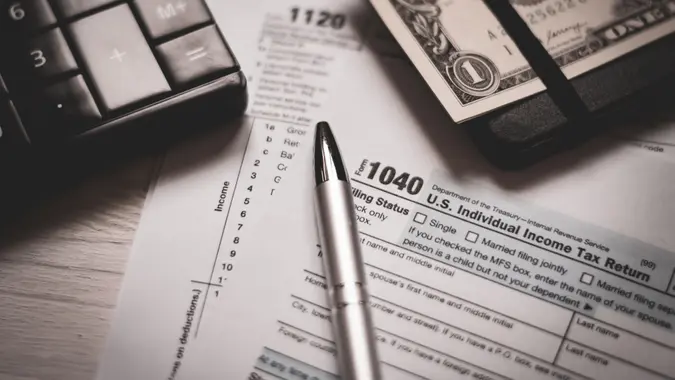How To File Taxes When You Have Multiple Jobs

Commitment to Our Readers
GOBankingRates' editorial team is committed to bringing you unbiased reviews and information. We use data-driven methodologies to evaluate financial products and services - our reviews and ratings are not influenced by advertisers. You can read more about our editorial guidelines and our products and services review methodology.

20 Years
Helping You Live Richer

Reviewed
by Experts

Trusted by
Millions of Readers
Battling inflation. Insulating against possible layoffs. Monetizing a hobby. Just trying to get ahead.
For these and other reasons, more Americans are working multiple jobs these days. That means adjustments in how they handle their taxes.
“We’re definitely seeing more people picking up side gigs and self-employed jobs, as well,” said Lisa Greene-Lewis, a CPA and tax expert with TurboTax. “For some people, hobbies or passion projects are turning into side jobs.”
Greene-Lewis pointed to TurboTax’s latest tax trend report, which found that 8.1% of tax filers included a form (1099-NEC or 1099-K) on their tax year 2022 taxes, indicating that they are self-employed or had a side gig — up from 6.7% the previous year. Last November, USA Today reported that people with multiple jobs represented 5.2% of the workforce, the highest total in nearly four years.
Filing taxes with multiple jobs isn’t generally all that different compared to filing with a single job. You’ll still only need to file one return with the Internal Revenue Service. That said, keep in mind that working an additional job may push you into a higher tax bracket, and be aware of these possible wrinkles.
Beware of Withholding Too Little
Withholding, always crucial to get right, becomes a bit more complicated with more than one job. Alison Flores, a manager with The Tax Institute at H&R Block, said that insufficient withholding is the most common issue when it comes to filing taxes for multiple gigs.
“It’s really important to make sure you’re withholding the right amount overall,” Flores said.
If the IRS withholds too much of your earnings each paycheck, you’re letting the government earn interest off your money that you could be earning instead. If the IRS withholds too little, you could owe them a bunch of money at tax time. So it’s important to consider how much you’re having withheld across all of your jobs.
The potential tax impact of your additional job will vary with how many hours you’re working that second job and how much money you’re bringing in.
“Sometimes you can make up for your self-employment taxes by withholding more for your job with your regular employer,” Greene-Lewis said.
Beware, though, of side gigs that start small and become a sizable portion of your income. Your withholding will likely need to keep pace. For help determining how much to have withheld, you can also check the IRS Tax Withholding Estimator tool.
Be Careful Around Social Security Taxes
If you’re working more than one job, be sure to keep the Social Security tax limit in mind.
This limit means you stop paying into Social Security once you’ve earned a specific amount in any given year. For 2024, the Social Security tax limit is $168,600.
Earn less than that, and you’ll usually pay 6.2% of your earnings in Social Security tax — with your employer matching that. If you’re self-employed, you’ll usually contribute 12.4% of your earnings to Social Security. But if you reach more than $168,000 earned for the year, those taxes should no longer be taken out. This is important to note if an additional job — or jobs — pushes you over this threshold.
“If you add another employer, they may not be aware of your other income,” Greene-Lewis explained.
She added that it is possible to request a refund if excess Social Security taxes are taken out but that it’s better to avoid the issue in the first place.
Make Sure You’re Aware of Possible Deductions
Side hustles and self-employment often mean a whole new tier of possible deductions.
“A lot of it is the simple things,” Flores said. “If you’re using your own vehicle, you are probably deducting mileage expenses. When you buy equipment, you can probably deduct or [depreciate].”
While nearly 90% of tax filers take a standard deduction, working multiple jobs may make itemizing worth another look.
You May Have Additional Forms To Fill Out
Depending on what that second or third job looks like, you may have more paperwork to do.
For example, if you are working for Uber or DoorDash, or doing freelance work, you’ll likely need to fill out a 1099-NEC form. The “NEC” stands for “non-employee compensation,” also referred to as self-employment income or earnings from independent contractor jobs.
If third parties are paying you for goods and services via payment apps or credit, debit or gift cards, you’ll get a 1099-K to fill out — if you hit thresholds for the amount of money you’ve made and the number of transactions.
Don’t forget that you can always consult with a tax pro if you don’t feel confident filing on your own. Tax-savvy family members and friends are another option, and today’s tax software and apps can also help you navigate.
More From GOBankingRates
 Written by
Written by  Edited by
Edited by 

























